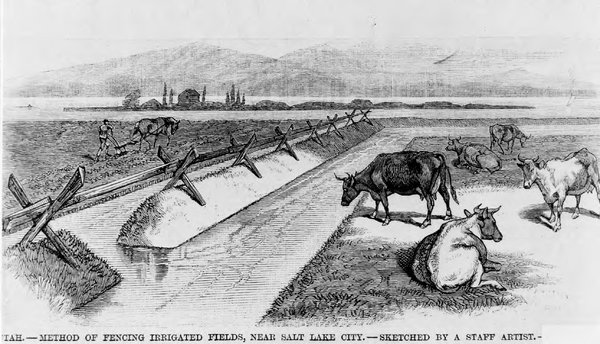Dublin Core
Title
Description
Irrigation was essential to early Mormons’ ability to survive in Utah. Learn how they labored physically, intellectually, and communally to make the desert bloom.
Looking back at the Mormons of the late nineteenth century, one historian joked that, while they took “the bee and its hive as [their] symbol… a more appropriate one would have been the beaver” and its dam. Indeed, to feed the tens of thousands of people who made their way to the Salt Lake Valley, Mormons had to redirect rivers, streams, and springs to water farm after farm after farm.
The LDS Church coordinated its members in the construction of communal irrigation projects. They had to water the desert – not only to feed themselves, but to make it “bloom.” By 1865, Mormons had dug 1,000 miles of canals in Utah. And, by 1890, they had irrigated nearly 265,000 acres of land to support over 200,000 people. While water diversion strategies had long been used by Native farmers in Utah, the Mormons were the first to attempt to irrigate the Great Basin on such a grand scale.
To put the land into production immediately, they initially relied on rudimentary structures like brush diversion dams and small canals to irrigate their fields. But eventually, they needed a much larger infrastructure to satisfy demand. All of this would take hard physical labor, of course, but it would also take technological know-how. So the Church sent young men like John Widtsoe to university to learn how to engineer adequate irrigation systems. At Harvard, Widtsoe learned to “[conquer] the desert… based on scientific study” and returned to Utah State Agricultural College, where he led efforts to improve Utah’s water infrastructure.
By the turn of the century, Utah grew more market-oriented and gave up its communal irrigation projects in favor of private control over water resources. Responsibility for irrigation shifted to private companies and with the passage of the Federal Reclamation Act in 1902, so began the era of building big dams in the West. What might Utah look like today if we had kept communal systems of water use?
Creator
Source
Image: Method of fencing irrigated fields, near Salt Lake City, Utah, about 1860-1865, Harper’s Weekly, No. 3405, Utah State Historical Society.
_______________
Dean L. May, Utah: A People's History, Salt Lake City: University of Utah Press, 1987; Donald Worster, Rivers of Empire: Water, Aridity, and the Growth of the American West, New York: Oxford University Press, 1992; “Using Water: Irrigation,” I Love History website, Utah Division of State History; Jennifer Haug, True Legacy of Utah Irrigation in the American West, Thesis, University of Utah, 2007.

